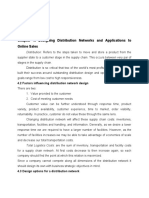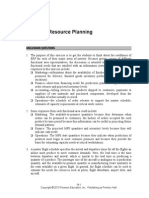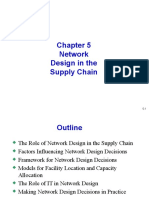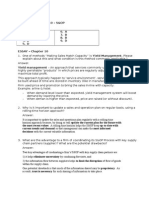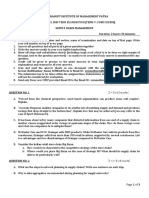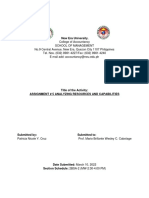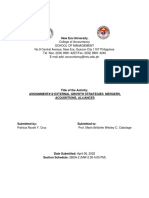Assignment Nos. 3 Supply Chain Management
Assignment Nos. 3 Supply Chain Management
Uploaded by
Patricia CruzCopyright:
Available Formats
Assignment Nos. 3 Supply Chain Management
Assignment Nos. 3 Supply Chain Management
Uploaded by
Patricia CruzCopyright
Available Formats
Share this document
Did you find this document useful?
Is this content inappropriate?
Copyright:
Available Formats
Assignment Nos. 3 Supply Chain Management
Assignment Nos. 3 Supply Chain Management
Uploaded by
Patricia CruzCopyright:
Available Formats
New Era University.
College of Accountancy
SCHOOL OF MANAGEMENT
No.9 Central Avenue, New Era, Quezon City 1107 Philippines
Tel. Nos. (632) 8981-4227/Fax: (632) 8981-4240
E mail add: accountancy@neu.edu.ph
Title of the Activity:
Assignment Nos. 3 Supply Chain Management
Submitted by: Submitted to:
Patricia Nicole Y. Cruz Prof. Mario Brillante Wesley C. Cabotage
Date Submitted: September 2, 2021
Section Schedule: 2BSA-4(TF-5:30-7:00 PM)
Please answer the following questions and submit on the deadline date.
1. Define supply chain management
The administration of the movement of goods and services is referred to as supply
chain management, and it covers all procedures that turn raw materials into finished
commodities. It involves a company's supply-side activities being actively reduced in
order to optimize customer value and obtain a competitive advantage in the marketplace.
Suppliers attempt to develop and operate supply chains that are as efficient and
cost-effective as practicable through supply chain management (SCM). Supply chains
includes everything from production-to-production process, as well as the information
systems required to accomplish these activities. Typically, SCM aims to centralize or link
a product's manufacturing, shipment, and distribution. Companies can save costs and
deliver items to customers faster by optimizing the supply chain. Internal inventories,
internal production, distribution, sales, and company vendor inventories are all under
tighter supervision.
2. What are the supply chain activities?
Farming, refining, design, manufacturing, marketing, and transportation are all
examples of supply chain activities.
3. What are the functions of supply chain management?
Aligning flows, integrating functions, coordinating processes, developing complex
systems, and managing resources are the five major functions of supply chain
management.
• Supply chain management maintains money, resources, and information going up
and down a supply chain by aligning flows between customers and providers.
• Supply chain management integrates logistics, buying, and operations activities
to ensure that they are focused on goals that promote overall performance.
• Supply chain management boosts profits by coordinating the processes that are
used to plan, source, manufacture, deliver, and (if necessary) return a company's
products and services.
• Designing Complex System- Simulators may be used to forecast how a supply
chain will behave and show how minor adjustments can cause big interruptions in
the flow of materials.
• Managing resources- Supply chain managers are in charge of ensuring that
customers' needs are met through the use of people, procedures, and technology.
4. What are the objectives of supply chain?
Every supply chain's objective is to maximize the overall value generated. The
difference between the finished product's value to the customer and the supply chain's
effort in fulfilling the customer's request is the value a supply chain generates. The value
of most commercial supply chains will be significantly connected with procurement
profitability, which is the distinction between revenue earned from customers and overall
supply chain costs.
The value of most commercial supply chains will be significantly connected with
supply chain profitability, which is the difference between revenue earned from customers
and overall supply chain costs.
5. Differentiate the cycle view and push and pull strategy.
The processes and owners of each process are clearly defined in a cycle view of
the supply chain. When making operational decisions, this perspective is quite valuable.
In a push-based supply chain, products are pushed through the channel from production
to retailers because it defines the duties and responsibilities of each member of the supply
chain including the intended results for each activity. Procurement, production, and
distribution in a pull-based supply chain are driven by demand rather by expectations.
Goods are made in the quantity and time required.
Reference/s:
CourseHero. (n.d.). Retrieved from
https://www.coursehero.com/u/file/81778789/Assignment-No3-Supply-Chain-
Management-1docx/?justUnlocked=1#question
Dummies. (n.d.). Retrieved from 5 Functions of Supply Chain Management:
https://www.dummies.com/business/management/5-functions-supply-chain-
management/
Fernando, J. (2021, August 30). Investopedia. Retrieved from Supply Chain
Management (SCM): https://www.investopedia.com/terms/s/scm.asp
Mukit. (2016, June 16). SCM Wizard. Retrieved from What is Supply Chain? The
Objective of a Supply Chain: https://scmwizard.com/what-is-supply-chain/
You might also like
- We Merged Now What?Document1 pageWe Merged Now What?RaizeL Rose50% (2)
- Message Header: Validation & Authentication of Standing Swift Wire TransferDocument3 pagesMessage Header: Validation & Authentication of Standing Swift Wire TransferCarlo Valencia67% (3)
- Advertising Primer - J.P. Morgan PDFDocument141 pagesAdvertising Primer - J.P. Morgan PDFSacred WingsNo ratings yet
- Naive Forecast MTCDocument2 pagesNaive Forecast MTCMuhammad RehmanNo ratings yet
- EssayDocument3 pagesEssayAditya PrasenanNo ratings yet
- Case Study of Woolworths Sa: Something in The Yoghurt MixDocument27 pagesCase Study of Woolworths Sa: Something in The Yoghurt MixEryne Riptantya50% (2)
- Rfid I S C: B & F: N Upply Hain Enefits UtureDocument19 pagesRfid I S C: B & F: N Upply Hain Enefits UtureDineshNo ratings yet
- IV Sem MBA - TM - Supply Chain Management Model Paper 2013Document2 pagesIV Sem MBA - TM - Supply Chain Management Model Paper 2013vikramvsu0% (1)
- Ba Zc411 Ec-3r Second Sem 2019-2020Document4 pagesBa Zc411 Ec-3r Second Sem 2019-2020AAKNo ratings yet
- ManualDocument41 pagesManualTuan Bình0% (2)
- Coordination in A Supply ChainDocument14 pagesCoordination in A Supply ChainPhD Scholar0% (1)
- Supply Chain Sourcing Week 5Document2 pagesSupply Chain Sourcing Week 5Sandeep Mandal0% (1)
- Syllabus Supply Chain Modeling IIMRDocument7 pagesSyllabus Supply Chain Modeling IIMROnal RautNo ratings yet
- Transportation & Distribution Planning: Instructor: Sayda Uzma Tahira Uzma - Tahira@ucp - Edu.pkDocument18 pagesTransportation & Distribution Planning: Instructor: Sayda Uzma Tahira Uzma - Tahira@ucp - Edu.pkArsalan ZahidNo ratings yet
- SCM AssignmentDocument2 pagesSCM AssignmentKING ME Gaming channel100% (1)
- MPCn8-Distribution Requirement PlanningDocument17 pagesMPCn8-Distribution Requirement PlanningRaunak BoseNo ratings yet
- Inventory Management - Lecture 3Document21 pagesInventory Management - Lecture 3AYESHA RASHID100% (1)
- Decision PhasesDocument2 pagesDecision Phasesdaddyaziz800% (1)
- Assignment Supply Chain ChopraDocument4 pagesAssignment Supply Chain ChopraUmair CheemaNo ratings yet
- IMT - Supply Chain MGMT - Session 11&12Document49 pagesIMT - Supply Chain MGMT - Session 11&12Himanish BhandariNo ratings yet
- Model Paper Marketing 2020-21Document2 pagesModel Paper Marketing 2020-21felix jebasinghNo ratings yet
- Supplier Customer Raw Materials Value ChainsDocument44 pagesSupplier Customer Raw Materials Value ChainsniyaramakrishnanNo ratings yet
- Chapter 4-6 SummaryDocument8 pagesChapter 4-6 SummaryDANIEL VILLARREALNo ratings yet
- Sunwind OverDocument7 pagesSunwind OverSambit PatraNo ratings yet
- Medical Technologies Corporation (MTC) Supply Chain StrategyDocument8 pagesMedical Technologies Corporation (MTC) Supply Chain StrategyLNPTNo ratings yet
- SCMPro Study Material-257-282Document26 pagesSCMPro Study Material-257-282Jay PatilNo ratings yet
- Logistics Management (Authored by Mehraj Kraipak)Document30 pagesLogistics Management (Authored by Mehraj Kraipak)M KNo ratings yet
- Supply Chain ManagementDocument20 pagesSupply Chain ManagementŞermin ŞahinNo ratings yet
- Case 1, GATIDocument7 pagesCase 1, GATIHuda MomaniNo ratings yet
- Assignment Questions GATIDocument4 pagesAssignment Questions GATIMEERALNo ratings yet
- IE3265 ForecastingDocument61 pagesIE3265 ForecastingVasundhara MahajanNo ratings yet
- 19 KRM Om10 Ism ch16Document36 pages19 KRM Om10 Ism ch16OPMANG100% (1)
- Retail Management & SCMDocument11 pagesRetail Management & SCMnithinsdnNo ratings yet
- C2. ElecComp (Chap 3) - Group 6Document15 pagesC2. ElecComp (Chap 3) - Group 6Novieka DistiasariNo ratings yet
- Case Study Erica CarsonDocument2 pagesCase Study Erica CarsonKeshav Chaudhari50% (2)
- 10 Commandments of Inventory ManagementDocument6 pages10 Commandments of Inventory ManagementJayesh BaldotaNo ratings yet
- Green Supply Chain - India Case StudyDocument6 pagesGreen Supply Chain - India Case StudyBradd CruiseNo ratings yet
- Saurav Das - 046 - Eprocurement at Cathay Pacific AirwaysDocument5 pagesSaurav Das - 046 - Eprocurement at Cathay Pacific AirwaysSaurav Arikadoshikaru DasNo ratings yet
- Mba ZG537 Ec-3r First Sem 2020-2021Document2 pagesMba ZG537 Ec-3r First Sem 2020-2021thasarathanr1993_939No ratings yet
- Distribution Requirement PlanningDocument17 pagesDistribution Requirement Planningresolution8878No ratings yet
- Rainfall Prediction in India Using Multiple Linear RegressionDocument3 pagesRainfall Prediction in India Using Multiple Linear RegressionBrian ChiefNo ratings yet
- Om & SCM Mba AimsDocument75 pagesOm & SCM Mba Aimsbhupesh joshi100% (1)
- 05 - Network Design in Supply ChainDocument21 pages05 - Network Design in Supply ChainAfnanNo ratings yet
- Chapter 2 - Supply Chain Performance: Achieving Strategic Fit and ScopeDocument2 pagesChapter 2 - Supply Chain Performance: Achieving Strategic Fit and ScopeseifSamhanNo ratings yet
- Chapter 10 Cycle InventoryDocument32 pagesChapter 10 Cycle InventoryTeklay TesfayNo ratings yet
- Supply Chain ManagementDocument12 pagesSupply Chain ManagementRazib Razon100% (1)
- CiscoDocument10 pagesCiscoChristine Barrera100% (1)
- Inventory Management - Lecture 1Document19 pagesInventory Management - Lecture 1Muhammad Naveed IkramNo ratings yet
- Case Study - Federal ExpressDocument26 pagesCase Study - Federal Expressvj_vinayNo ratings yet
- Caso de Estudio: Passenger InterchangeDocument2 pagesCaso de Estudio: Passenger InterchangeJuan PeresNo ratings yet
- Dell Supply ChainDocument16 pagesDell Supply ChainShuwing LeungNo ratings yet
- Supply Chain Answer KeyDocument7 pagesSupply Chain Answer KeyJoey Zahary GintingNo ratings yet
- Aggregate PlanningDocument7 pagesAggregate PlanningbalashankarrNo ratings yet
- An Introduction To Fastag: A Game Changer in Automatic Toll Collection Systems in IndiaDocument6 pagesAn Introduction To Fastag: A Game Changer in Automatic Toll Collection Systems in IndiaVinod AroraNo ratings yet
- InventoryDocument34 pagesInventorymbapritiNo ratings yet
- Chandragupt Institute of Management Patna: Will Not Be Considered For EvaluationDocument3 pagesChandragupt Institute of Management Patna: Will Not Be Considered For EvaluationAYUSH RAVINo ratings yet
- Operations Management AssignmentDocument7 pagesOperations Management AssignmentkritiwNo ratings yet
- Unit 5-Warehousing, Handling and Picking SystemDocument50 pagesUnit 5-Warehousing, Handling and Picking SystemMadhuri Dambal100% (1)
- Q.P. Code:36461: Activity Preceding Activity NT (Days) CT (Days) Blenders Packers FillersDocument3 pagesQ.P. Code:36461: Activity Preceding Activity NT (Days) CT (Days) Blenders Packers Fillersmms a19No ratings yet
- Assignment#10 Global Strategy and The Multinational CorporationDocument5 pagesAssignment#10 Global Strategy and The Multinational CorporationPatricia CruzNo ratings yet
- Assignment #11 Diversification StrategyDocument4 pagesAssignment #11 Diversification StrategyPatricia CruzNo ratings yet
- Assignment # 5 Analyzing Resources and CapabilitiesDocument4 pagesAssignment # 5 Analyzing Resources and CapabilitiesPatricia CruzNo ratings yet
- Assignment#12 External Growth Strategies Mergers, Acquisitions, AlliancesDocument3 pagesAssignment#12 External Growth Strategies Mergers, Acquisitions, AlliancesPatricia CruzNo ratings yet
- A7 Cruz ManalastasDocument4 pagesA7 Cruz ManalastasPatricia CruzNo ratings yet
- Gecaap-18 (M4a1 - A-B)Document3 pagesGecaap-18 (M4a1 - A-B)Patricia CruzNo ratings yet
- M10F1 Act. 1Document2 pagesM10F1 Act. 1Patricia CruzNo ratings yet
- Assignment 1Document2 pagesAssignment 1Patricia CruzNo ratings yet
- GECETH-18 (Assignment 3)Document2 pagesGECETH-18 (Assignment 3)Patricia CruzNo ratings yet
- GECAAP-18 (M6A1 Activity 2-3)Document7 pagesGECAAP-18 (M6A1 Activity 2-3)Patricia CruzNo ratings yet
- Gecaap-18 - M2a1Document1 pageGecaap-18 - M2a1Patricia CruzNo ratings yet
- GECETH-18 (Assignment 2)Document2 pagesGECETH-18 (Assignment 2)Patricia CruzNo ratings yet
- A1 Cruz ManalastasDocument3 pagesA1 Cruz ManalastasPatricia CruzNo ratings yet
- Aaca - m2 To 5Document13 pagesAaca - m2 To 5Patricia CruzNo ratings yet
- A6 Cruz ManalastasDocument3 pagesA6 Cruz ManalastasPatricia CruzNo ratings yet
- Course OutlineDocument2 pagesCourse OutlinePatricia CruzNo ratings yet
- SPECTRANS Module 3-5Document36 pagesSPECTRANS Module 3-5Patricia CruzNo ratings yet
- Patricia Nicole Y. Cruz 2BSA-4 STS-M5L2Assign2Document1 pagePatricia Nicole Y. Cruz 2BSA-4 STS-M5L2Assign2Patricia CruzNo ratings yet
- Spectrans M1 M2Document7 pagesSpectrans M1 M2Patricia CruzNo ratings yet
- Patricia Nicole Y. Cruz 2BSA-4 Module 6 Lesson 1 Seatwork 3Document4 pagesPatricia Nicole Y. Cruz 2BSA-4 Module 6 Lesson 1 Seatwork 3Patricia CruzNo ratings yet
- STS M5L3SW2Document1 pageSTS M5L3SW2Patricia CruzNo ratings yet
- N Ew Era University: A Case Study in Partial Fulfillment of The Requirements in Strategic Business ManagementDocument21 pagesN Ew Era University: A Case Study in Partial Fulfillment of The Requirements in Strategic Business ManagementPatricia CruzNo ratings yet
- Gaddi, Maria Ynalyn V. 2BSAIS-3 Assignment No. 7 StrabaDocument6 pagesGaddi, Maria Ynalyn V. 2BSAIS-3 Assignment No. 7 StrabaPatricia CruzNo ratings yet
- An Organisational Study at "Mahaveer Real Estate PVT LTD"Document8 pagesAn Organisational Study at "Mahaveer Real Estate PVT LTD"Vamshi KrishnaNo ratings yet
- BA234 Unit 5Document6 pagesBA234 Unit 5Winces Lou PilotaNo ratings yet
- Sbi Project ReportDocument117 pagesSbi Project ReportSai PrintersNo ratings yet
- Raghu Ram Chittibommala Company Law Problems and SolutionsDocument39 pagesRaghu Ram Chittibommala Company Law Problems and SolutionsCh SubrahmanyamNo ratings yet
- MNC SeminarDocument12 pagesMNC Seminarmanindersingh949No ratings yet
- BASCO With You. Buying Your Boat With BASCODocument8 pagesBASCO With You. Buying Your Boat With BASCOAgus Wibowo PurnomoNo ratings yet
- Mold Tek ProfileDocument10 pagesMold Tek Profilevenky4mbhavansNo ratings yet
- Goldline Defence Towers 04-Aug-23Document11 pagesGoldline Defence Towers 04-Aug-23Faizan KarsazNo ratings yet
- Highlight IFRSDocument16 pagesHighlight IFRSBảo Hân VũNo ratings yet
- Business Plan Trust InvestingDocument14 pagesBusiness Plan Trust InvestingLorhan Do ValeNo ratings yet
- Guidelines For Rating PADocument2 pagesGuidelines For Rating PAMohammed AldaffaieNo ratings yet
- ISO 13485 Process MatrixDocument2 pagesISO 13485 Process MatrixManjunath BNo ratings yet
- Career Day PresentationDocument12 pagesCareer Day PresentationHainsley EdwardsNo ratings yet
- Financial Analysis of Astrazeneca and GSKDocument29 pagesFinancial Analysis of Astrazeneca and GSKBhavishNo ratings yet
- Dollar Store Segment AnalysisDocument13 pagesDollar Store Segment AnalysisRichard O'BrienNo ratings yet
- Test NameDocument4 pagesTest NameGramos MetajNo ratings yet
- Chapter 6 International SellingDocument28 pagesChapter 6 International SellingSanaullah BhattiNo ratings yet
- M2 Audit Working PaperDocument6 pagesM2 Audit Working PaperCheesy MacNo ratings yet
- Fahmi - Pengertian IPO 395200-None-10830dedDocument15 pagesFahmi - Pengertian IPO 395200-None-10830dedgintingprabawaluyoNo ratings yet
- DPR FormatDocument4 pagesDPR Formatjasaulakh0% (1)
- Humanology Company ProfileDocument22 pagesHumanology Company ProfileHumanologyNo ratings yet
- Module 1-5 QuestionarireDocument44 pagesModule 1-5 Questionarirevaibhav kumar Khokhar0% (1)
- Jamila Bombaywala: US Work Authorization - Legal Permanent Resident (Green Card)Document2 pagesJamila Bombaywala: US Work Authorization - Legal Permanent Resident (Green Card)Ashwani kumarNo ratings yet
- W12PM Ghufran IntermediateDocument12 pagesW12PM Ghufran IntermediateGhufranNo ratings yet
- Case Analysis of Suman & CompanyDocument6 pagesCase Analysis of Suman & CompanyPragati AryalNo ratings yet
- EPlanet HCM FeaturesDocument4 pagesEPlanet HCM FeaturesirfanNo ratings yet
- Jack Welch Case StudyDocument6 pagesJack Welch Case StudySunil Patil100% (1)























